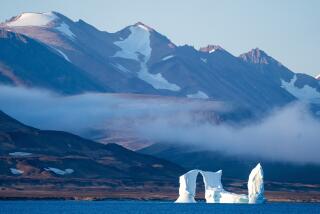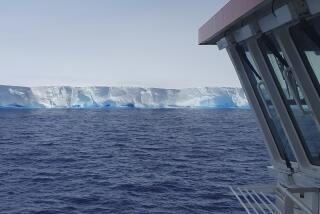Oceanographers Hitch Sub Ride to Arctic
- Share via
ABOARD THE USS POGY — Ray Sambrotto is a little out of touch.
He can’t be reached by phone, fax or e-mail. He won’t see this year’s World Series, or join the rest of the planet in enduring the final weeks of the 1996 U.S. presidential election. He’ll even miss the trees bursting into red, orange and gold near his Hudson Valley home.
The soft-spoken oceanographer has been thrown into one of the most isolated environments on the planet, a place a colleague calls “a sensory-deprivation tank with company.”
Until Nov. 12, Sambrotto’s home is the nuclear fast-attack submarine Pogy.
It’s all in the name of science. In a gesture of post-Cold War largess, the U.S. Navy has awarded the scientific community five free submarine trips to the Arctic Ocean over as many years.
Scientists are clamoring for a chance to use the submarine, because the Arctic Ocean has emerged from obscurity in recent years. It once was thought of as a remote wasteland untouched by human activity, Sambrotto said. But in the last decade or two, scientists have found that the far north is tightly integrated into a global ecological web.
“When you study and you get involved in these kinds of things, it makes the world seem very small,” said Barry Hargrave, a researcher at the Bedford Institute of Oceanography in Canada who contributed an experiment to the sub trip.
The Pogy, named for a small silver fish that lives in the North Atlantic, is on the second of the five planned submarine voyages to the top of the world. The depths of the Arctic Ocean are virtually unexplored, having been visited only occasionally in the past by the Navy’s nuclear subs. And most of those missions were classified.
The second trip, which will cover 8,000 nautical miles of virtually uncharted territory, began Aug. 27.
“It suddenly gives you access to an area that previously was inaccessible,” said Sambrotto, a research scientist at the Lamont-Doherty Earth Observatory in Palisades, N.Y., and the chief scientist on the trip.
But that access comes at a price. Scientists who sign on for the cruises have to live for months in some of the most cramped conditions imaginable.
“You’ve got basically a sealed container with 130 guys on board,” said Bernard Coakley, who participated last year in the first cruise, as well as a trial run two years ago.
Navy submariners use every cubic inch of space they have, but there just isn’t much to go around. Bunks line the vessel’s corridors, and nautical charts sit in metal cases hung on the walls. On longer voyages, canned provisions are stored on the decks and covered with plywood sheets. For weeks, the crew walks around on top of its own food.
Because of the tight quarters, the Navy doesn’t allow women to serve on submarines.
While surface ships can be fairly easily rigged up for both sexes, Cmdr. James T. Reilly said, subs are so compact that retrofitting the fleet would be impossible. There are only five bathrooms on the sub for a crew of 135, and one is the exclusive domain of the commander.
“I’m very pleased to leave it to my compatriots,” said Coakley, who also is an oceanographer at Lamont-Doherty and is sitting out this year’s cruise.
For scientists, working aboard a nuclear submarine means sharing laboratory space with torpedoes and clambering out onto the frozen sea in subzero weather conditions to take water and ice samples.
Unless there are polar bears about. During last year’s cruise on the sub Cavala, the scientists and crew were surprised to find bears nosing around at two of the five spots where they surfaced. In both cases, the researchers waited patiently until the bears ambled off.
Ursine visitors aside, the Arctic Ocean is arguably the most desolate place on Earth.
“It’s the last unexplored part of the world,” said George Newton, a member of the U.S. Arctic Research Commission.
The Antarctic is colder, but the fact that it’s a continent makes the world’s southernmost regions more accessible.
The Arctic is an ocean six times the size of the Mediterranean that freezes over and then partially thaws annually. It can be an impenetrable plate of sea ice or a hazardous flotilla of ice floes.
In the last few decades, scientists have studied the Arctic Ocean on icebreakers and even by camping on ice floes drifting around the high seas. But even the sturdiest ships can get only to places where the ice isn’t too thick, and floes go where the winds and currents blow them. So until they got access to the Navy’s subs, scientists didn’t have the ability to point at a spot on the map and say, “Take me there.”
On this year’s cruise, the Pogy embarked from San Diego and headed for the Bering Strait, the narrow strip of water that separates Alaska and Siberia. Upon passing through the strait, the sub will crisscross the Arctic Ocean four times.
Most of the scientific investigations planned are funded by the government through the National Science Foundation and the Office of Naval Research, and related to environmental changes in the Arctic.
In the last few years, Sambrotto said, climatologists have found the Arctic is a sensitive climatic region that can change rapidly in response to disturbances from down south. And changes in the Arctic also can affect life in more temperate parts of the globe.
For example, researchers predict that any global warming caused by humans will happen first and be most severe in the polar regions. So it’s critical to monitor the temperature of the Arctic Ocean for signs of warming. Temperature measurements taken by an icebreaker in 1994 suggest that the Arctic Ocean has warmed since the 1960s, Sambrotto said, and the submarine’s work could help confirm those measurements.
But the submarine isn’t just taking the ocean’s temperature. It is tying together a complete picture of the Arctic with dozens of studies that generally fall into four categories:
* Water properties. The scientists are charting the chemical and physical properties of water bodies as the submarine passes through them. The oceans may seem like one big pool, but they actually contain identifiable water masses that don’t mix because their differing densities make them like oil and vinegar.
* Pollution. The submarine also samples for a host of pollutants. Scientists want to know how much pollution is reaching the Arctic and how it’s getting there. Figuring out how pollution gets to the Arctic and what it does when it gets there also could provide valuable information about ocean currents.
* Geology. One instrument measures Earth’s gravitational pull on the submarine as the craft plies Arctic waters. The force of gravity will increase slightly as the sub passes over slightly denser-than-average rocks, and decrease when it cruises over rocks that are lighter than the surrounding terrain. Then geologists will try to use that information to piece together the Arctic’s geologic character and history, which in some regions is a complete mystery. Other instruments also will help by mapping the bumps, troughs and other features of the sea floor.
* Ice. Several studies gauge how the Arctic Ocean’s surface ice changes through space and time. The north polar icecap is a vital part of Earth’s climate system, and changes in its size could have profound effects on the weather just about everywhere.
“It looks from all the records that we have now that the Arctic has been more dynamic than the rest of the globe,” Sambrotto said. “It’s not just a remote place that has no bearing on what happens anywhere else.”






